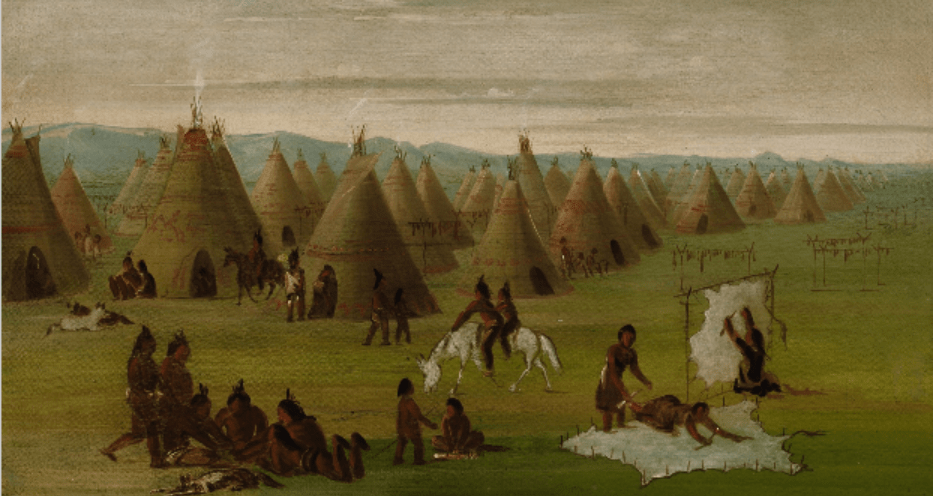
A little over ten miles north from where the San Saba and Colorado Rivers converge, a meeting once took place between Indian agent and Texas State Legislator Robert Simpson Neighbors and several important chiefs from the Penatuhkah Comanche. Among those assembled at a large Comanche camp was Chief Sanaco, whose story we’ll follow a bit today. From a description of this meeting I found in Linda Pelon’s book,Texas Comanche Land Revisited, I think this village was probably in the vicinity of Nabors Creek Cemetery, just south of Goldthwaite.
“On April 2, 1849 Sanaco’s camp on the Colorado was reached,” reads a quoted paragraph from Robert Simpson Neighbors and the Texas Frontier in Pelon’s book. “His camp was near the mouth of Spring Creek, which is about twelve miles as the crow flies, above the confluence of the San Saba and Colorado rivers. This was the site of the battle where the Comanches defeated Colonel John Moore in 1839. Besides the band of Sanaco, at the camp, Yellow Wolf’s band was present, as well as part of Buffalo Hump’s. The camp was so large, that Rip Ford estimated the number of Indians at 10,000.” That’s a lot of people at this meeting–about half the population of Brownwood today!
Along with Santa Anna and Buffalo Hump, Chief Sanaco was one of the foremost leaders of the Penatuhkah Comanche, the Native American tribe that once inhabited our area. Unlike Chief Santa Anna, who was often remembered as jovial and good-humored, Sanaco was described by Neighbors as, “A haughty, difficult Indian,” as recorded in Jeff Davis’s Own Cavalry, Comanches and the Battle for the Texas Frontier by James Arnold. “At one time Sanaco had sent a message to the agency to announce that he would come to the reserve if the agent would provide plentiful good whiskey and that he would stay as long as the whiskey lasted. Since that time he had been implicated in numerous Indian depredations. Most recently, his band had killed some settlers, stolen livestock, and hurried off to the sanctuary of the country bordering the upper Red and Canadian Rivers. When officers and men learned that their objective was to hunt down Sanaco, they nodded their heads with pleasure. He was just the sort of enemy they expected. Probably none knew that Texans had killed Sanaco’s father back in 1840 while he was attending a peace negotiation, and that revenge motivated the son.”
It is possible that the father of Sanaco referenced above was Chief Muguara, AKA Mukewater, who was killed at the treacherous Council House Fight of 1840. Pelon states “One unverified source reported that Muguara […] was Santa Anna’s father and that Sanaco was his brother. Information collected from Fredericksburg also indicated that Santa Anna and Sanaco were brothers.” This would possibly have made Sanaco and Santa Anna brothers with Chief Yellow Wolf as well, another prominent Comanche leader, according to what I have read. It’s difficult to ferret out these relationships for a certainty, as accounts were often recorded second hand or years after an event took place.
Sanaco seems to have been a temperamental, yet compelling and powerful character whose influence was prominent on negotiations and the eventual removal of the Penatuhkah tribe to an initial reservation inside Texas. “Comanche Chief Sanaco who led the southern or Penateka band arrived at Neighbor’s camp along the Clear Fork of the Brazos River, 11 miles west of present-day Woodson in southeastern Throckmorton County (Neighbours 1975:149),” states the TXDOT-info website.
“He brought with him several subchiefs and a chief of the middle Comanche, all pledging to abide by the requirements of reservation life. Chief Sanaco said, ‘You come into our country and select a small patch of ground, around which you run a line, and tell us the President will make us a present of this to live upon, when everybody knows that the whole of this entire country, from the Red River to the Colorado, is now, and always has been, ours from time immemorial. I suppose, however, if the President tells us to confine ourselves to these narrow limits, we shall be forced to do so, whether we desire it or not.’ Chief Sanaco along with other Comanche leaders expressed their desire to have a reservation located along the Clear Fork of the Brazos River in the vicinity of the council grounds, which was one of the Comanche’s wintering places.”
The town of Sanco, in Coke County, is named after Sanaco, and is an area where he was known to camp frequently. This now ghost town was reportedly built on the site of the old Comanche Village, and Yellow Wolf Creek runs nearby this camp. The next time you drive down south of Brownwood, towards the Colorado, imagine what it would have been like to see the land filled with thousands of Comanche, to listen as their leader Sanaco sat on the ground with agent Neighbours, bargaining for the lives of his people. Tough as he may have been, Sanaco possibly had a softer side, as recorded in the book, Wild about Horses, by Lawrence Scanlan, where this story is told. “An American army captain once offered a large sum of money for the favorite horse of Sanaco, a Comanche chief. He declined to sell his buffalo horse lest his people suffer. Besides, Sanaco said, stopping to pat the pony on the neck, ‘I love him very much’.”
***
Diane Adams is a local journalist whose columns appear Thursdays on BrownwoodNews.com. Comments regarding her columns can be emailed to [email protected].
